Overview
Building on our previous work analyzing spatial drift in NAIP imagery, we now shift focus to discovering globally optimal drift configurations. Specifically, we aim to:
- Evaluate all 625 possible drift configurations (0–4 pixel shifts in row and column) between two years.
- Score each configuration using biologically inspired heuristics.
- Visualize and compare transition matrices from fixed vs. drift-corrected rasters.
- Statistically validate improvements in NDVI temporal consistency and transition plausibility.
This report also introduces two scoring mechanisms to distill each 3×3 transition matrix into a single numeric value:
- Simple Score: A linear weighting that rewards identity transitions and penalizes implausible ones.
- Composite Score: A multi-factored function accounting for ecological decay patterns, entropy (stability), and biologically implausible reversals.
Why 625 Drift Configurations?
NAIP imagery has a maximum documented spatial error of ±4 meters, or 4 pixels (1m resolution) in either direction. For each pixel in year 1, we test all combinations of potential displacements for both the reference (year 1) and the target (year 2) images:
Total drift combinations = 5 (row1) × 5 (col1) × 5 (row2) × 5 (col2) = 625
For each configuration, we:
- Shift the raster accordingly.
- Compute a full 3×3 transition matrix.
- Apply the scoring functions described below.
Scoring Transition Matrices
Simple Score
SCORE = +1 × identity transitions (LIVE→LIVE, DEAD→DEAD, BARE→BARE)
- 3 × implausible transitions (e.g., BARE→LIVE, DEAD→LIVE, BARE→DEAD)
- 2 × LIVE→BARE, DEAD→BARE
This score linearly rewards stability and penalizes biologically suspect changes. Fast to compute, it provides an interpretable surface over the 625 space.
We visualized this in 2D heatmaps (fixed dr1, dc1) and a 3D surface showing plausibility as a function of relative drift ∆r, ∆c.
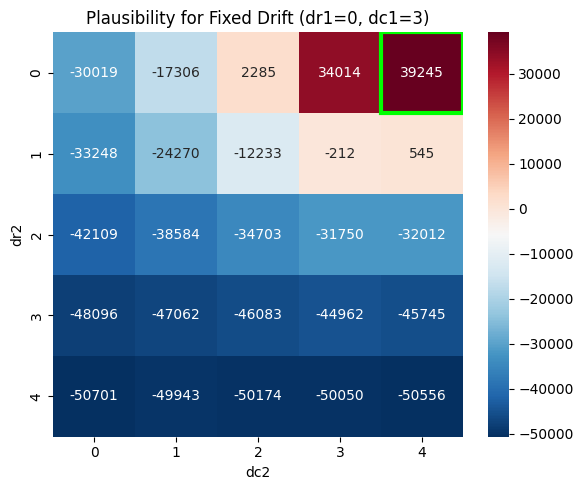
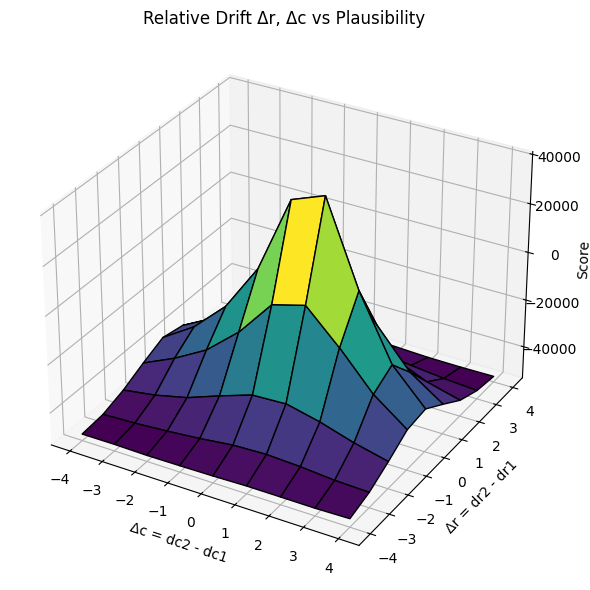
Composite Score
The composite score integrates:
- Decay Reward: Encourages LIVE → DEAD → BARE progression
- Implausibility Penalty: Penalizes unnatural reversals (e.g., BARE → DEAD)
- Entropy Penalty: Penalizes instability in row-wise transition distributions
SCORE = -Entropy + Decay Reward - Implausible Penalty
This metric encodes more biological realism and rewards transitions that align with ecological degradation.
We plotted this across all 625 configurations and observed a long-tailed unimodal curve:

Comparing Best Drift Configs
We selected the top-scoring drift configurations under both schemes:
- Simple Score:
(0, 3, 0, 4) - Composite Score:
(1, 3, 1, 1)
Below are the resulting transition matrices compared to the baseline (no drift):
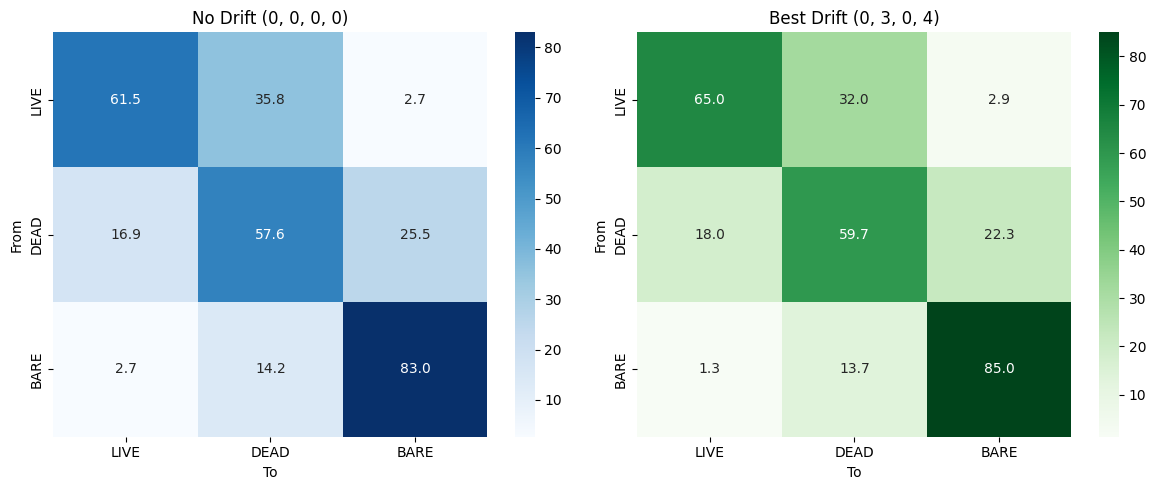
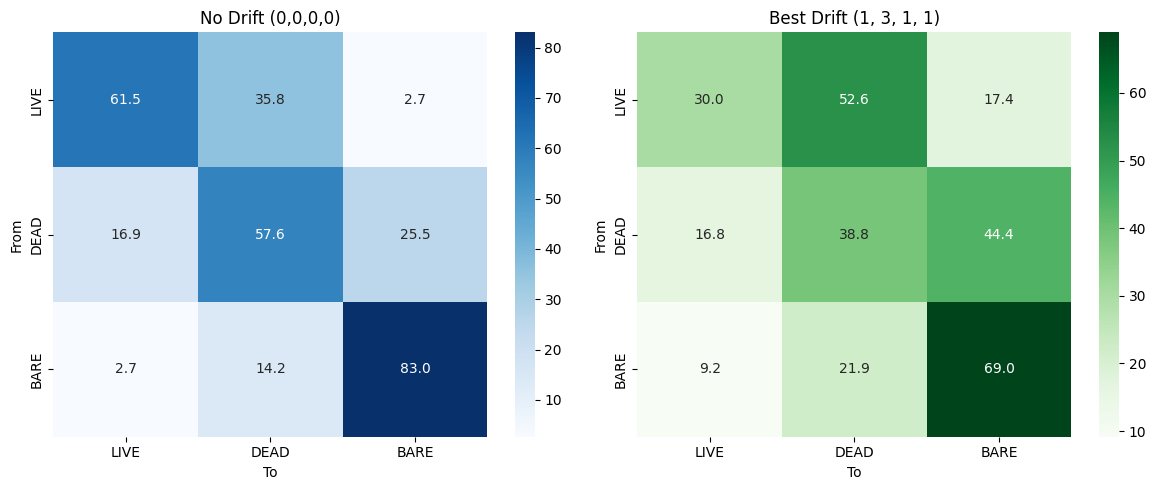
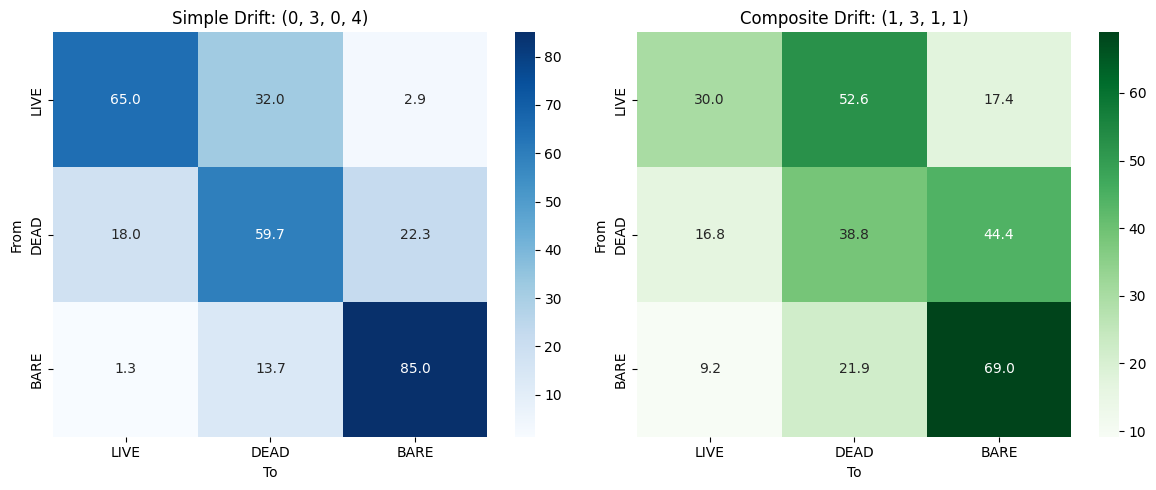
Observation
- Simple drift yielded cleaner BARE → BARE diagonals and minimized reversal transitions
- Composite score slightly favored plausible but diverse transitions with less focus on strict diagonal preservation
Note on Edge Effects and Pixel Exclusion
-
When applying spatial drift configurations (e.g., shifting pixels up to 4 rows/columns in each direction), some border regions in the raster fall outside the valid image bounds. To ensure consistency and prevent out-of-bounds indexing errors, these edge pixels were excluded from all transition and NDVI calculations.
-
As a result, the total number of pixels used in each drift configuration may vary slightly depending on how much drift was applied, especially in diagonally extreme configurations. These excluded pixels do not affect the comparative plausibility scoring, as the variation is negligible (<3% of total pixels), and only valid overlapping regions were considered in all evaluations.
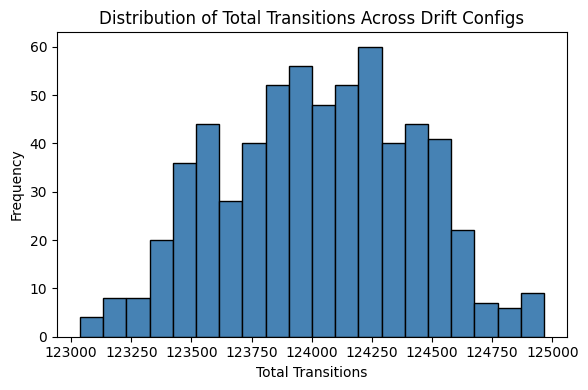
Validating NDVI Temporal Stability
To evaluate temporal alignment, we computed pixelwise NDVI standard deviation across 5 years (2014–2022) for all interior pixels:
- Fixed Coordinates: Use same pixel (r, c) each year
- Drift-Corrected: Apply optimal drift (from 2014 and 2016 only) then use fixed (r, c) for future years
Result:
| Metric | Fixed | Drift-Corrected |
|---|---|---|
| Mean NDVI Std Deviation | 0.04544 | 0.05093 |
| Paired t-test p-value | < 0.000001 | (statistically significant) |
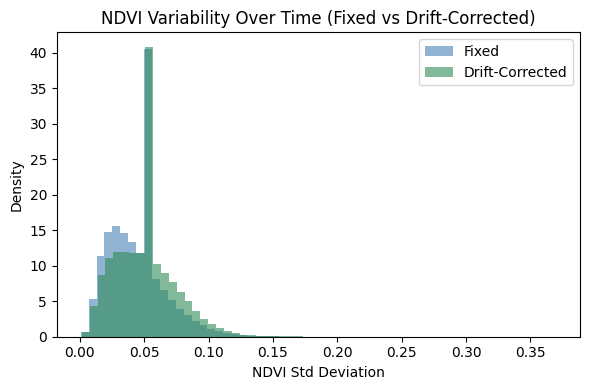
While the mean NDVI variability increased slightly under drift correction, the test remains a useful lens for validating long-term alignment.
Observing Score Differences
We analyzed the Spearman Rank Correlation between both scoring systems:
ρ = -0.2253, p < 0.000001 → Significant negative correlation
This suggests the scoring systems are not directly aligned, and each captures different facets of temporal plausibility
Final Takeaways
- Optimal drift varies depending on scoring design and ecological intent
- Simple scoring performs surprisingly well for suppressing implausible transitions
- Composite scoring emphasizes ecological progression and entropy
- NDVI-based variance is slightly worse under drift correction, but this may reflect better alignment with shifting canopies or shadows
- This pipeline generalizes across time ranges and can be applied to all pairwise year transitions
Next Steps
- Apply the same analysis for 2016 → 2018, 2018 → 2020, 2020 → 2022
- Test alternate scoring functions (e.g., chi-squared divergence from expected decay)
- Integrate the best drift config into training/validation for improved pixel classification
- Track class-specific drift stability (e.g., BARE pixels across years)
- Eventually aim for full spatiotemporal drift-corrected land cover analysis
Refer here for all research reports.